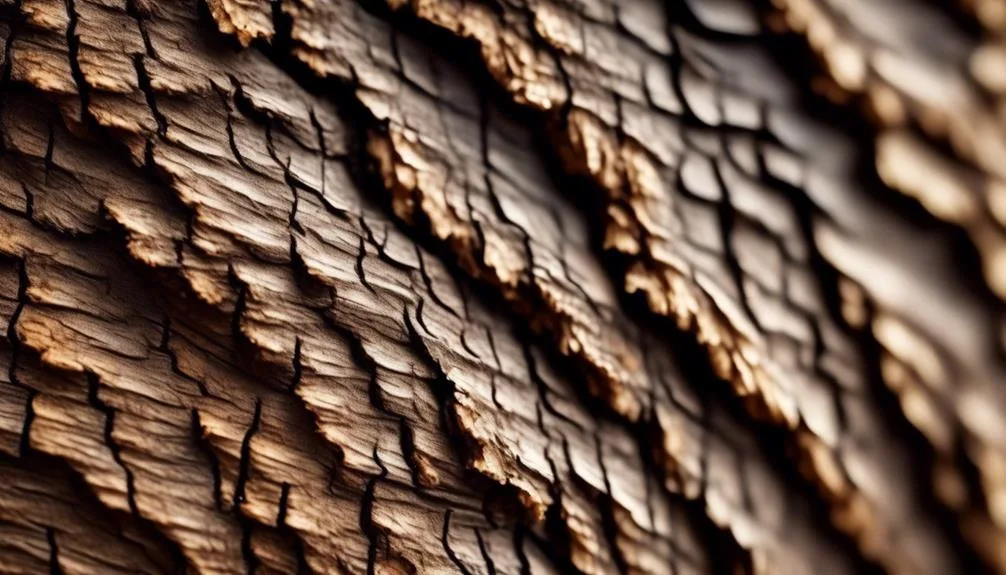Standing under the vast branches of a hickory tree, you might have wondered if its bark is edible. Exploring the nutritional value and historical uses of this overlooked resource is crucial.
Before considering it as a food source, it's important to understand the facts and potential risks. Let's delve into the question of whether hickory tree bark is edible and what you need to know.
Edibility of Hickory Tree Bark
Yes, hickory tree bark is indeed edible and has been used for various culinary and medicinal purposes for centuries.
The bark of the hickory tree is known for its medicinal properties and has been used in traditional medicine to treat various ailments such as sore throats, coughs, and colds. It has also been used as a natural remedy for skin irritations and inflammations.
In addition to its medicinal properties, hickory tree bark has historical uses in culinary practices. Native American tribes used the inner bark as a flour substitute, and it was also used as a flavoring agent in some dishes.
The edible nature of hickory tree bark opens up a world of possibilities for incorporating this natural resource into modern cooking and alternative medicine.
Nutritional Value of Hickory Tree Bark
Transitioning from the discussion of the edibility and historical uses of hickory tree bark, let's now examine its nutritional value and potential benefits.
While hickory tree bark isn't commonly consumed for its nutritional benefits, it does contain small amounts of dietary fiber, which can support digestive health.
Additionally, some indigenous cultures have used hickory tree bark for its medicinal properties, suggesting potential health benefits.
However, it's important to note that consuming tree bark should be approached with caution and only under the guidance of a knowledgeable expert, as some bark may contain compounds that are toxic or harmful.
Preparation and Consumption of Hickory Tree Bark
When considering the preparation and consumption of hickory tree bark, it's essential to understand the proper methods and potential risks involved in utilizing this natural resource.
Processing techniques for hickory tree bark include thorough cleaning to remove dirt and debris, followed by drying and grinding into a fine powder. This powder can be used as a thickening agent in soups or stews, or brewed into a tea.
Traditional uses of hickory tree bark also include chewing on small pieces to extract the sap, which was historically used for its medicinal properties. However, it's crucial to note that consuming hickory tree bark should be approached with caution due to potential risks such as contamination and the presence of tannins, which can cause digestive discomfort.
Always consult with a knowledgeable source before attempting to consume hickory tree bark.
Potential Risks and Considerations
Exploring the potential risks and considerations associated with consuming hickory tree bark is crucial for making informed decisions about its use.
While hickory tree bark has been used for various medicinal and culinary purposes, it's important to be aware of potential risks before incorporating it into your diet.
One significant risk is the potential for allergic reactions, particularly in individuals with known tree nut allergies.
Additionally, consuming large quantities of hickory tree bark may lead to digestive discomfort or stomach upset.
It's essential to exercise caution and moderation when considering the consumption of hickory tree bark.
Safety precautions include consulting with a healthcare professional before using hickory tree bark, especially if you have underlying health conditions or are taking medication.
Always ensure that the bark is harvested from a safe, pesticide-free environment to minimize potential risks.
Conclusion
In conclusion, it's essential to approach the consumption of hickory tree bark with caution and informed consideration due to the potential risks and individual health factors involved. Before deciding to consume hickory tree bark, consider the following:
- Edible Alternatives: Explore other edible parts of the hickory tree, such as nuts or sap, as safer and more widely accepted alternatives for consumption.
- Cultural Significance: Research the cultural significance of hickory tree bark in different traditions and communities, as it may provide valuable insights into its historical use and safety considerations.
- Consultation: Prior to consuming hickory tree bark, consult with a knowledgeable herbalist, botanist, or healthcare professional who can provide informed guidance based on individual health factors.
- Sustainable Harvesting: If harvesting hickory tree bark for non-consumptive purposes, ensure sustainable practices to preserve the tree's health and ecosystem.
Conclusion
Given its tough and fibrous texture, hickory tree bark, though technically edible and historically used for its medicinal properties, isn't a common food today.
Considering potential risks, it's advisable to opt for the safer and more palatable nuts and leaves of the hickory tree.
This highlights the importance of understanding traditional uses of natural resources and exercising caution when exploring unconventional food sources.
Mark Hoffman is a dedicated arborist and tree care specialist with over a decade of experience. His love for trees began when he visited Yosemite National Park as a teenager and was awestruck by the giant sequoias. Mark pursued his passion by studying forestry at Michigan Technological University, where he earned a Bachelor of Science degree.
Since then, he has worked tirelessly in the field of arboriculture, helping to preserve and protect trees in his community. His expertise and dedication have made him a respected leader in the industry and a valuable resource for anyone seeking advice on tree care.
